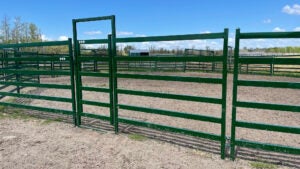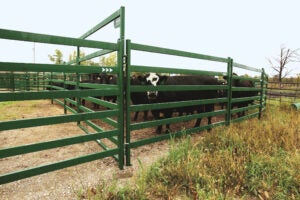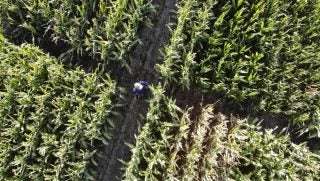Working on a ranch takes a significant amount of time and effort, so finding ways to work cattle as efficiently as possible is essential. When finding ways to increase efficiency on the ranch, most people will consider the features of larger equipment such as cattle chutes, tubs, and alleyways. Often, the smaller (but still important) pieces of equipment, such as chute accessories, gates, and corral panels, are considered an afterthought. However, they are just as important.
The materials your panels are made with, how they are designed, and where they are placed in your cattle handling facility could be slowing down your operation rather than helping it. If you’re looking to improve your operation and speed up processing time so you can check more things off the ever-growing “to-do list,” then it’s important to consider how your corral panels could improve efficiency.
Optimize corral layout by avoiding corners
When designing your cattle handling facility, cattle corral panels should be one of the first things you consider. These are often the main components of your system, and how your cattle system is designed can make or break the efficiency of your operation.
As you think about the design of your system, it’s important to remember to avoid corners. Though it is easier to build your cattle handling system by placing panels together to create corners, this design can increase the chances of injury. When cattle are placed in high-stress situations, like a handling system, they’re more likely to hide in the corners, which means you’ll have to put yourself in a potentially dangerous area to guide the animal out and back in the right direction. Cattle can be unpredictable at times — especially in high-stress situations — so it’s crucial you do your best to avoid scenarios where you may be trapped or injured by an upset or stressed animal.

Opting for a more circular layout with corral panels can enhance safety and efficiency. A round design encourages better cattle flow by working with the animal’s natural behavior to follow curves and create a more low-stress experience for everyone involved. By lowering stress in the system, cattle will be more cooperative and easier to handle, which will, in turn, speed up processing time.
Consider square rails over round rails in your corral panels
Running a cattle operation requires a lot of work, so investing in high-quality corral panels built to withstand daily use and rowdy cattle is essential. This and proper regular maintenance will ensure the cattle panels will last for years. As you look for different options on the market, you want to pay close attention to the panels’ build and the material from which they’re made.
Consider panels built with heavy-duty, North American steel and designed using square railings rather than rounded, as it’s been proven that a 1-inch square rail is 33 percent stronger than a 1-inch round railing. This is because the cross-sections are stronger and provide more support to withstand cattle of any temperament. Additionally, the squared panel rails reduce carcass bruising because the contact point is more significant, which spreads the pressure when cattle contact the rails; and as all ranchers know – preventing bruising on cattle can help save you hundreds of dollars annually when it comes to sale time.

Using squared or rectangular railed panels can also provide visual benefits. The thicker rails provide a larger visual barrier, making them easier for cattle to see. As a result, cattle are less likely to challenge the corral panels, which reduces the need for constant replacements, saving you money in the long run. Reducing the chances of cattle challenging panels will lead to an easier, safer, and more positive processing experience that will save you time.
Select the right corral panel size for your needs
Ensuring you have the proper panels for the job you need is crucial for maintaining the safety and efficiency of your cattle handling system. There are many things to consider when it comes to the dimensions of the panels, including the height, the length, and how far apart the rails are. Using panels that are the right height will reduce the chances of cattle jumping over them while being run through your system, which, in turn, will reduce the likelihood of injury. As well, you want to consider panels with progressively spaced rails to avoid cattle getting their heads or legs stuck. If an animal gets stuck in your corral panels, you’ll need to take time away from more critical tasks to help get the animal unstuck, which no rancher wants to do.
Recently, Arrowquip extended its lineup of Arrow Elite and Arrow Pro cattle corral panels, so you can now choose from a wider array of sizes. The Arrow Elite Cattle Panels are now available from 4 feet to 14 feet, so you can place them anywhere you need to create the cattle handling system of your dreams. They also come with an all-new lifetime warranty, guaranteeing a lifetime of protection.
The Arrow Pro Cattle Panels are built for areas of your cattle handling system that are a little more low-stress and come in three sizes: 8 ft, 10 ft, and 12 ft. Ideally, these panels will be set up along the outer edges of your handling system so that the larger sizes will be a perfect fit. They also have an upgraded 5-year warranty, so you can handle cattle with peace of mind.

Investing in high-quality corral panels designed with animal science in mind is key to enhancing cattle handling efficiency in your operation. By considering these three things when purchasing cattle panels, you can create a more effective system for managing your cattle.
If you’d like more information on Arrowquip’s Cattle Corral Panels, feel free to visit www.arrowquip.com or contact their team at 1-866-383-7827.
This article was published on behalf of Arrowquip.


